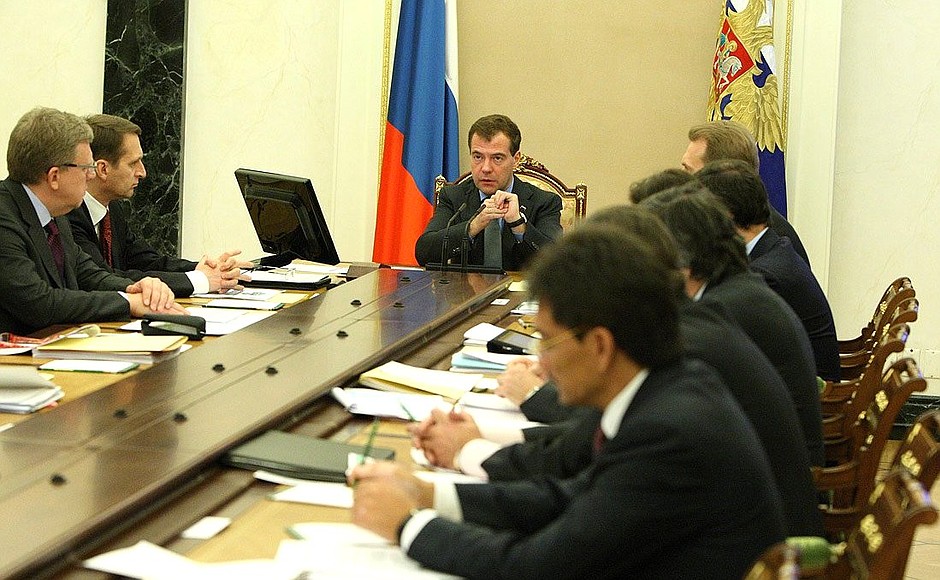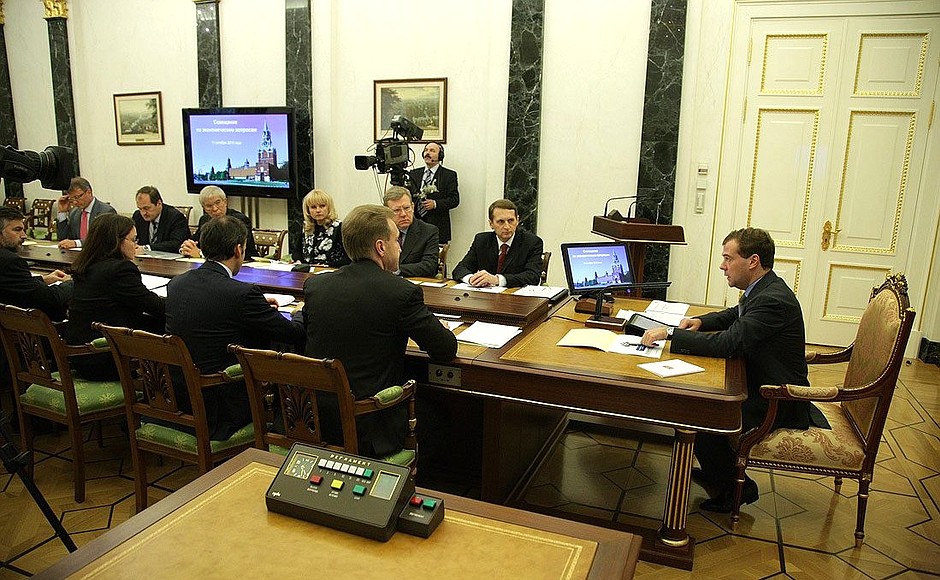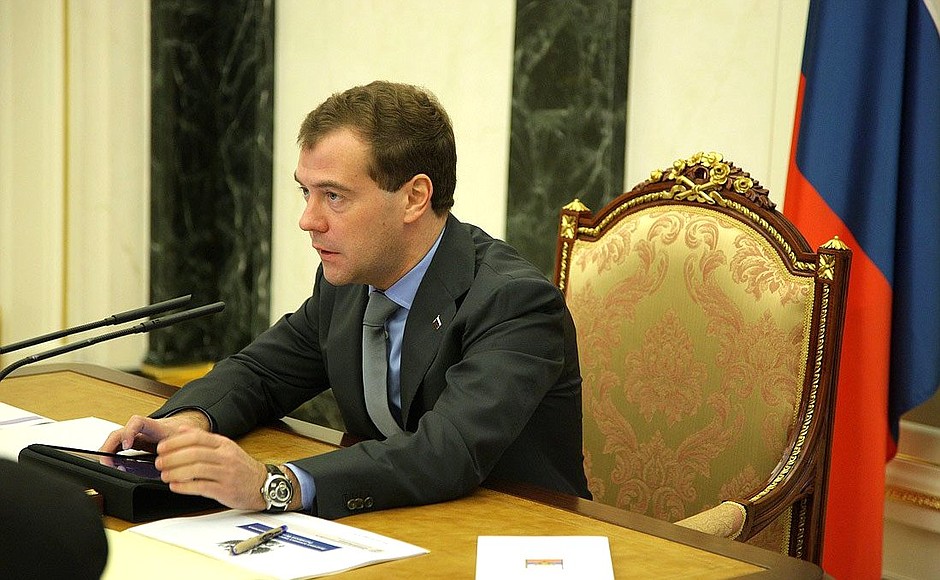Commenting on the current economic parameters, the President noted the increase in industrial production compared to the same period in 2009, and also growth in retail trade and the average wage, which surpassed pre-crisis levels.
The meeting also discussed the situation on the job market, the state of the credit system, and ways of making the Russian market more attractive for investors.
Among those taking part in the meeting were Chief of Staff of the Presidential Executive Office Sergei Naryshkin, First Deputy Prime Minister Igor Shuvalov, Deputy Prime Minister and Finance Minister Alexei Kudrin, Presidential Aide Arkady Dvorkovich, Healthcare and Social Development Minister Tatyana Golikova, Economic Development Minister Elvira Nabiullina, and Chairman of the Central Bank Sergei Ignatyev.
* * *
President of Russia Dmitry Medvedev: I’d like to pass on everyone’s greetings from Skolkovo – greetings from American entrepreneurs, as well as the Governor of California, who brought them here.
Today, we are having a regular meeting on economic issues. Our agenda includes traditional topics: current economic parameters, our current state of affairs, and what we must do to keep up the positive trend that has formed since mid-2009 and which we are currently maintaining.
According to the Ministry of Economic Development – I think this will be addressed in more detail later – we registered a growth of 3.7 percent between January and August of this year, as opposed to a 10 percent decline during the same period last year. Naturally, there are sectors that are growing faster, and in general, this isn’t bad.
What’s very important is the state of the labour market, which the Cabinet recently discussed. This may well be one of the most fundamental social indicators and is very sensitive for all of our citizens. By summer of this year, unemployment in our nation decreased to seven percent – or even less – of the economically active population, whereas last year, the figure was significantly greater. (The beginning of the year was also very complicated for us; indeed, that is when the trends we’ve been discussing started to manifest themselves, when the growth of unemployment surpasses even the economic drop – the economic decline levels off, while unemployment continues to grow.)
Overall, the decline in unemployment is a comforting fact. We need to strengthen these positive trends. And naturally, this serves as evidence that the measures taken by executive authorities ultimately had their intended effect.
Wages continue to grow. In real terms, they already exceed their pre-crisis levels. Overall, this is another topic that requires a separate analysis of all its elements.
In the first eight months of this year, retail turnover grew by almost four and a half percent. Consumer spending is one of the main factors in economic growth. We will talk more about anti-crisis measures later.
Nevertheless, we need to give attention to the remaining problems; there are still plenty of them. Investment demand is slowly recovering. Between January and August of this year, investments grew by only 2.8 percent; granted, this figure dropped by 20 percent during the same period last year.
We are also facing new challenges, of which you are well aware. The key challenge has to do with the very harsh weather conditions of this year’s summer – the drought, crop failures, growth in grain prices and other agricultural products. Overall, prices are remaining unstable and we are still monitoring them. In September, I took a whole series of trips to our key regions. Overall, nothing dramatic is happening, but nevertheless, the situation should put everyone on their guard, and governors, as well as Cabinet members, should approach it mindfully. In many cases, we were able to keep the prices down, and even stop the price growth for some products, but certain difficulties remain. Thus, I count on our economic block chiefs present here to speak on this subject.
I’d like to say a few words about the state of the credit system. Much like the macroeconomic indicators mentioned earlier, the indicators pertaining to our credit system have generally been positive this year. In comparison to last year, Russia’s international reserves have increased, the ruble has strengthened against foreign currencies, and consolidation processes in the banking sector, as well as banks consolidation, have become more active. The fact that our people generally trust our banking system is an important indicator. It is evidenced by the volume of retail deposits, which grew by nearly 16 percent since the beginning of the year. Naturally, this is also the result of the ruble getting stronger, which has both a positive and not entirely positive dimension. But in any case, for the situation overall it was in a sense a positive thing.
In turn, the banks have begun to lend more to citizens. The volume of loans extended to small and medium-sized businesses has grown by more than 17 percent. The measures we took to lower the loan rates played an important role. At the same time, the low cost-effectiveness of many businesses still does not allow them to take out loans even at these relatively low rates. Often, the banks choose not to invest into the real sector, focusing instead on less risky marketable securities, whose portfolio has increased by one third since the beginning of this year. Naturally, this is a serious indicator.
Clearly, one of the ways to increase lending activity is to strengthen trust between creditors and borrowers. This is a complicated process that involves a regulatory aspect as well as a psychological aspect, which is certainly important. This needs to be done, in part by broadening the range and assuring the reliability of pledge instruments – the instruments we have to ensure fulfilment of obligations. We have discussed different approaches to this matter, and we have debated different instruments, including certain lesser-used institutions such as intellectual property. In any case, we need to create conditions for broader use of intellectual property as a way to ensure the fulfilment of loan obligations. Following my instructions, this issue is already being studied and has been included in the Cabinet’s work agenda.
These are our current issues. I would like to once again note that this is a regular meeting. I am glad that our extraordinary – special — meetings on economic issues are just about over for this year. Last year, we met very frequently, and naturally, it is no secret that our discussions were difficult. But this year, the situation is somewhat different, so I would like you to speak in more detail about your views on how the main economic processes are developing.
<…>


